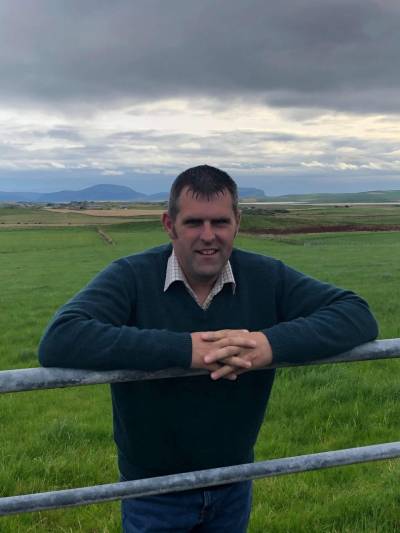
I was brought up on a small, family beef farm in the parish of Harray in the Orkney Islands and from an early age I had a keen interest in cattle, especially beef cows. In 2006 my wife Lorraine and I were fortunate to be offered a farm to buy, and since then have purchased another farm and built the herd up to 100 cows. We farm 330 acres, 230 which are owned and 100 on seasonal lets. We have Simmental and Salers cross cows and sell the calves as stores, and we also grow some spring barley.
In 2012 we were fortunate to become Orkney’s first Monitor Farm. At the start of the project a whole farm review was carried out on the business. The whole farm review programme is carried out by someone completely independent to highlight the strengths, weaknesses, opportunities and threats to the business. The review highlighted that our herd was not achieving targets for cows scanned in calf, live calves born, and calves weaned, as recommended by both QMS and SRUC.
Farmers are often told by industry experts how we needed to be more efficient by achieving 96% scanning, 94% live calves and wean 92% from every one hundred cows exposed to the bull, all in a 9 to 12 week breeding period. However, Quality Meat Scotland estimates that only 82% of cows in Scotland are producing a calf each year. So, we are rearing 10% less calves than what we are being told is possible. Either these targets are unrealistic or we as an industry are under achieving. I wanted to find out if these targets were realistic, which prompted two questions that I wanted to answer through my Nuffield Scholarship:
- What is a realistic weaning percentage?
- How do you achieve this?
My study tour in 2015/16 covered farms in the UK, Canada, Ireland, Norway and Sweden. Visiting farms in the UK and Ireland first, I wanted to know what they were achieving. I asked all the farmers the same 22 questions to find out what breeds, housing, forage type, minerals, feeding method, management and health planning they had. But, most importantly, what was their scanning, calving, weaning and replacement rate.
I have seen very different systems; from Highland cross cows on the hills of Scotland, to pedigree herds on the east coast working well alongside successful arable systems. Cowboys farming thousands of acres on the edge of the Rocky Mountains, to very highly stocked family farms in Ireland. Every farmer I have met is passionate about cows and a lot of them are in the process of expanding cow numbers.
My study tour has reinforced to me the importance of cow type, management, 2-year-old calving and block calving. But I have also noticed that a few of the farms I have visited were weaning calves which are close to 50% of the cow’s body weight. At home we are not achieving this and the last time the cows and calves were weighed at weaning they were only 45% average. They varied from 32% to 66%. To try and achieve better and more uniform weights I intend to reduce the average weight of the cows by selling off the biggest cows and culling cows which consistently under perform. I also intend to supplement the cows better before calving to improve the quality of colostrum. I hope this will improve the health of the calves in the first few months of life. Our scanning rate has been 93%. I hope by culling cows which have had calving difficulties, we can achieve 95%.
Only 10% of the farmers I met in the UK were achieving better than the target of 92%. The main focus of my study was to compare the top 10% with the bottom 10% of the farmers which I met, which would represent the average suckler producer in Scotland. My findings have shown that 92% is setting the bar to High. Breed and type of cattle does matter. Continental and native breeds have different strengths and when you combine the two you can have the best of both worlds. Heifers should be calved at two years old unless it is an extensive system using slow maturing, hardy breeds which do live longer. Block calving within 9 or at the most 12 weeks is achievable with the right management and cow type. All the other management practices, services and products are important but can vary greatly between farms.
After visiting farms in different countries which are achieving 92% weaning, I am in no doubt that the industry can improve greatly on what is being achieved at the moment. Farmers have all the tools and information already to achieve this. It is time to get this message across.
View Steven’s Nuffield Farming Scholarship Report – Are benchmarking targets for suckler cows achievable 2015_UK_Steven Sandison_Are-Benchmarking-Targets-For-Suckler-Cows-Achievable.pdf (nuffieldscholar.org)